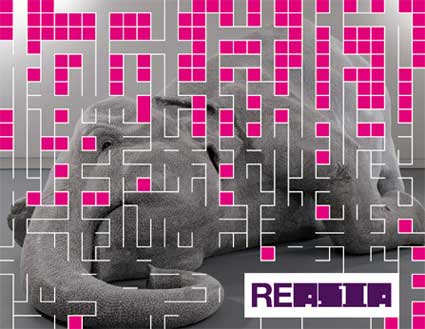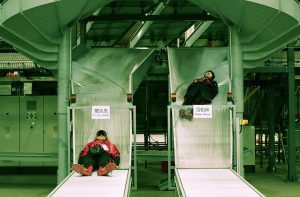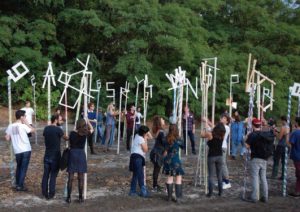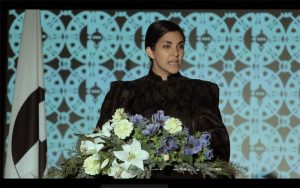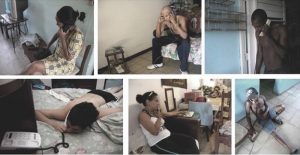Notes from the Re-Imagining Asia exhibition at The House of World Cultures in Berlin. The exhibition and other events, curated by Wu Hung and Shaheen Merali, examine how contemporary artists around the world re-invent the image we might have of Asia and the way in which the post-colonial production of knowledge is challenging Euro-centric concepts of art.
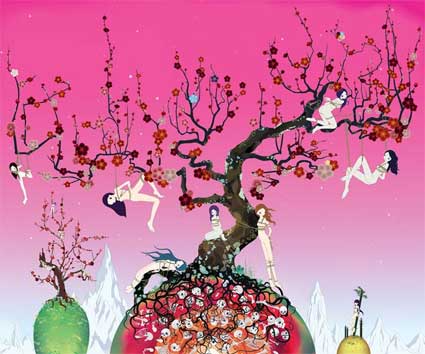 Chiho Aoshima, Japanese Apricot 3 – A pink dream, 2007. (bigger version Galerie Emmanuel Perrotin)
Chiho Aoshima, Japanese Apricot 3 – A pink dream, 2007. (bigger version Galerie Emmanuel Perrotin)
Asian art has reached a point where it is almost too hot to handle. New museums and art biennials are popping up all over the continent, the price paid to get a piece of Chinese art are going through the roof and Indian paintings and installations are exhibited all over Europe. Asian art is now so hype that one might think that another exhibition will just kill the enthusiasm. Well, this one won’t. The works on show have not been selected for the artists’ origins but for their focus on Asia as a space for the imagination. There are Chinese, Indian, Thai and Japanese artists but they are joined by Mexican, Germans and American artists.
As you enter the foyer of the House of World Cultures, you meet with Song Dong’s installation Waste Not. It is nothing else but his parents’ wooden house, which fell victim to urban planning in China. He reconstructed the house together with its entire inventory, a collection of utensils of all kinds accumulated by the artist’s mother over a period of 50 years and offering a picture of 50 years of material culture in China. It is hard to imagine how several tv sets, so many kitchen utensils, books, old shoes, toys, buckets, plastic bags, ballpoint pens, cupboards, etc could fit into the tiny dwelling.
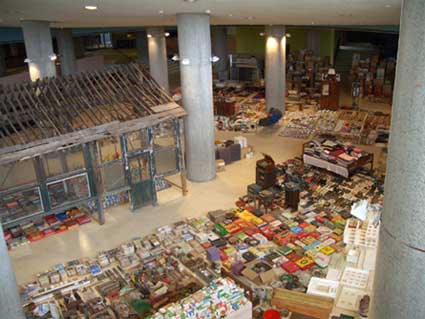 Image HKW
Image HKW
Song Dong grew up in Beijing. His mother taught him how to make the most of few resources, recycling, re-allocating and saving utensils for future use. The socialist motto was: ‘Waste not’. The shabby borough he lived in has been cleared away for the Olympics a few years ago, but the government neglected to replace the old houses, so there is now an empty area.
On it Song Dong would like to build another wooden house in the traditional style as a call for the preservation of old Beijing.
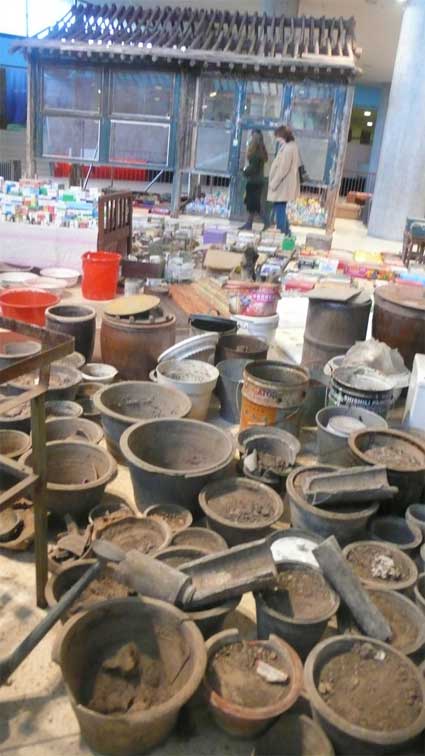
Besides offering visitors a picture of Beijing life, the installation has relieved his mother of the dead weight of half a century and has done so without making her feel that her hoarding was futile. In fact she fulfilled the role of an artist herself by preparing the show. And each of her mundane and utilitarian objects has been elevated to the status of artwork.
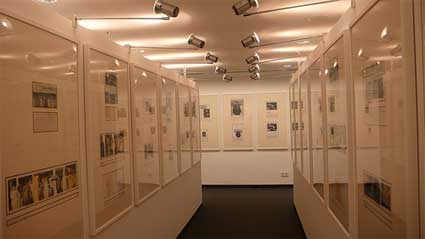 View of the installation at HKW
View of the installation at HKW
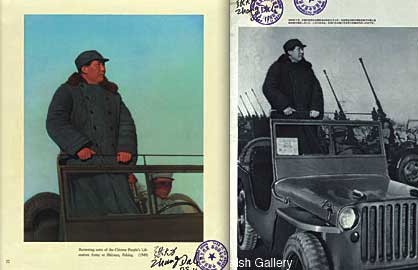 Chairman Mao at Xiyuan Airport, Beijing, March 1949*, 45″ x 25″, Ed. 19, digital c-print, 2006
Chairman Mao at Xiyuan Airport, Beijing, March 1949*, 45″ x 25″, Ed. 19, digital c-print, 2006
Zhang Dali‘s “A Second History” was probably the work i found most fascinating. It’s a collection of copies of Mao-era doctored “official” photographs paired with the unaltered originals.
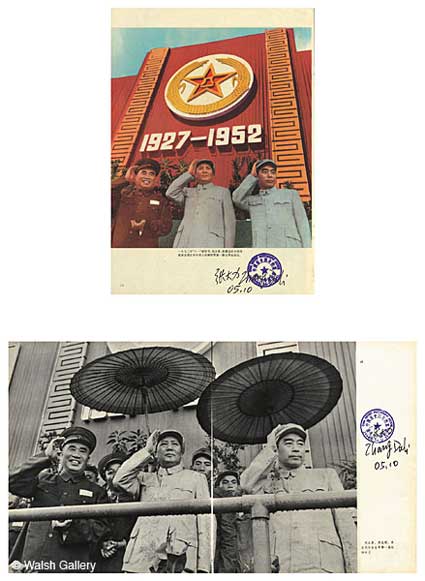 The First Sports Meeting of the National Army, 1952*, 45″ x 25″, Ed. 19,
The First Sports Meeting of the National Army, 1952*, 45″ x 25″, Ed. 19,
digital c-print, 2006
The work presents an “archive of the Chinese Revolution” in 3 parts: Mao and the Revolution, Heroes and the Masses, People’s Pictorial Archive. By presenting side by side unaltered photographies from original negatives and the images as they appeared in the media at the time, the installation shows how deliberate distortion of images became an essential mechanism of photo production, a way to satisfy a yearning for an idealized image and a propaganda tool. Long before the arrival of computer and photoshop. The methods used in the editing of these images involve mainly painting: a wrinkle between Mao’s eyebrows vanishes, superfluous figures in the background are erased. (more images of Zhang Dali.)
And in no particular order:
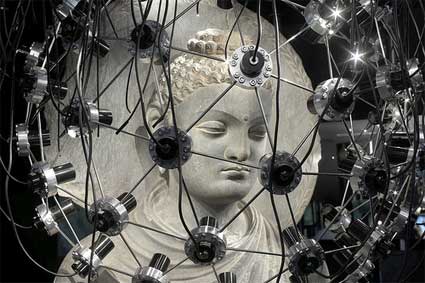 Michael Joo, Bodhi Obfuscatus (Space-Baby), 2005. Photo: Tom Powel Imaging
Michael Joo, Bodhi Obfuscatus (Space-Baby), 2005. Photo: Tom Powel Imaging
The Bohdi Obfuscatus (Space Baby) by Michael Joo embodies perfectly the tensions and harmonies between novelty and tradition. In an homage to Nam June Paik, Joo borrowed a Korean Buddha from a local shrine and encased it in a halo of surveillance cameras, Fiber-optic lights cast projections onto flat TV screens while mirrors, mounted on poles that surround the sculpture, reflect images from the video displays, the Buddha sculpture and visitors as they walk around the installation.
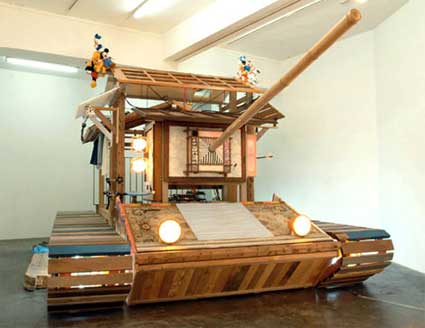 Ozone – So Provided by Mizuma Art Gallery. Courtesy of Munteru
Ozone – So Provided by Mizuma Art Gallery. Courtesy of Munteru
Ujino Muneteru was in the house two. I only got to see the Ozone – So installation, a wooden temple turned into a tank and adorned with waste material, such as electric appliances, plush toys, bits of carpet, building materials and books collected around Tokyo by volunteers.
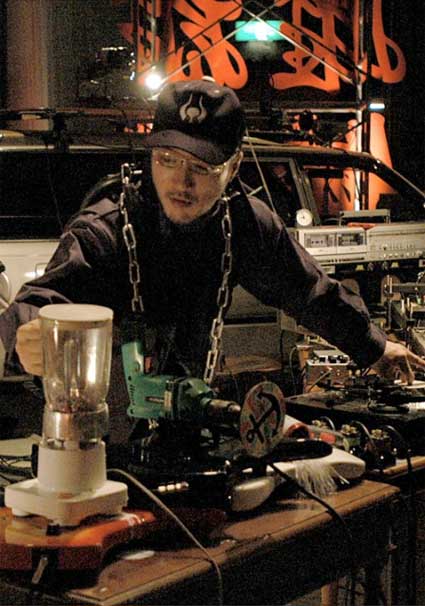
There was also the video of a musical performance Muneteru gave in Berlin. He played with blenders, hair dryers, parts of bicycles, used vinyl discs, turntables, not only was it fascinating to see him handle all this junk but it also sounded surprisingly good.
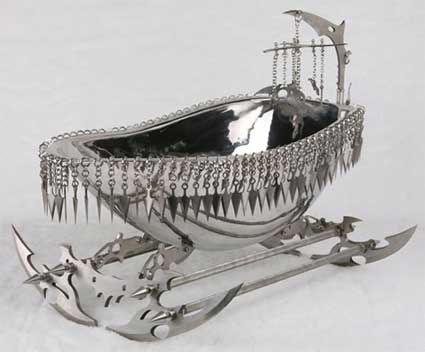 Shi Jinsong, Na Zha Cradle, 2005
Shi Jinsong, Na Zha Cradle, 2005
Shi Jinsong‘s razor-sharp line of baby products include a militarized Carriage, a sadistic Cradle and a predatory Walker. Na Zha Baby Boutique (Na Zha is a child warrior deity in Chinese mythology) tries to lure “shoppers” using stainless steel “products” which evoke both luxury and danger.
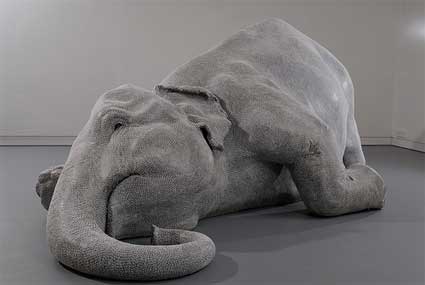 Bharti Kher, The Skin Speaks a Language Not Its Own, 2006. Photo credit:Pablo Bartholomew/Netphotograph.com
Bharti Kher, The Skin Speaks a Language Not Its Own, 2006. Photo credit:Pablo Bartholomew/Netphotograph.com
Bharti Kher’s bindi-on-fiberglass elephant. The bindi in India is traditionally a mark of pigment applied to the forehead of men and women and is associated with the Hindu symbol of the ‘third eye’. When worn by women in red, the bindi symbolises marriage. In recent times it has become a decorative item, worn by unmarried girls and women of other religions.
Bharti Kher covered her sculpture of a dying elephant in white bindi. The elephant is often regarded in Asia as a symbol of dignity, intelligence and strength. Kher marries the elephant and the bindi to contemplate the effects of popular culture, mass media and consumerism on the culture of India.
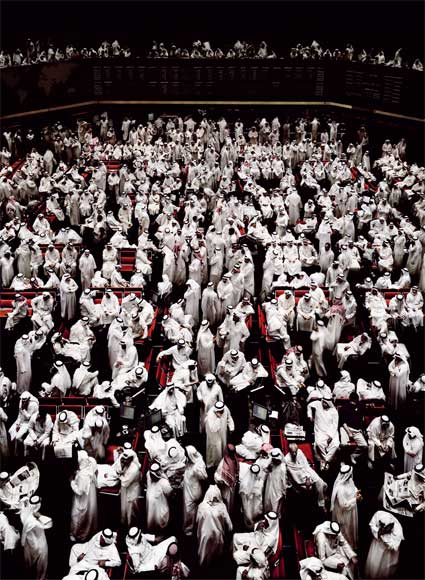 Andreas Gursk, Kuwait Stock Exchange. © Andreas Gursky / VG Bild-Kunst, 2007
Andreas Gursk, Kuwait Stock Exchange. © Andreas Gursky / VG Bild-Kunst, 2007
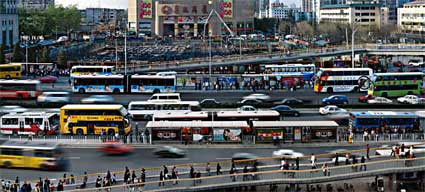 Miao Xiaochun, Orbit, digital c-print, ed. of 3, 2005, 85.5″ x 189″ (bigger version of the image)
Miao Xiaochun, Orbit, digital c-print, ed. of 3, 2005, 85.5″ x 189″ (bigger version of the image)
I took a few pictures. Universe in Universe has more images of the show.
Related: Chiho Aoshima, Mr. and Aya Takano in Lyon.
